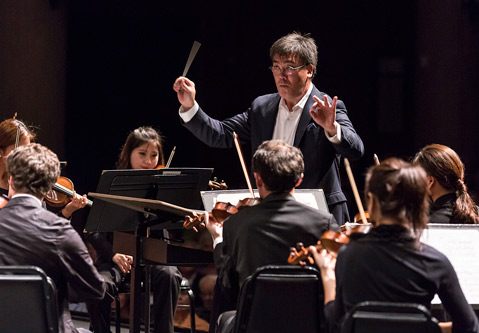Review: The Academy Festival Orchestra at the Lobero Theatre
Alan Gilbert Conducted the AFO on Saturday, July 26

Alan Gilbert, the charismatic leader of the New York Philharmonic, took the stage at the Lobero on Saturday with a question that was tinged with irony. “Do you like Arnold Schoenberg?” he asked the audience in the hearty tone of a rock star. The response, although sprinkled with laughter, was a roar of approval. He then reminded the enthusiastic listeners of Schoenberg’s history with the Music Academy, and of the “difficult, but with heart” musical romanticism of this early, adventurous, but not yet atonal work. Then he and the young musicians plunged in to the Chamber Symphony No. 1 in E-flat Major, Op. 9, which remains one of the 20th century’s wildest musical rides. Gilbert’s decision to augment the original arrangement, which was scored for 15 individual instruments, with additional strings — he referred to it as a “bulked up” version — might be the subject of some well-informed second guesses, but there was no confusion when it came to the sound he got from these players, which was outstanding.
Next up was another exciting 20th century chamber symphony, this one by Thomas Ades. This 1990 composition is an altogether idiosyncratic work, playful to the point of perversity, and filled with both jazzy, unpredictable rhythms and odd, unconventional instruments, including an accordion, the inimitable “boing” of a Flexitone, and the improvised wind instrument created when one blows across the top of a wine bottle. Gilbert joked that the note hit by this not-empty bottle could be heard to fluctuate during rehearsal, a nod to our city’s special relationship with wine that was clearly part of his excellent rapport with the Academy fellows. Thomas Ades, who will appear at the Music Academy as conductor for the Festival Orchestra’s season finale, has the compositional panache and sophistication to make something this eccentric work, and the audience left for intermission buzzing with the youthful energy represented by both the players on stage and the composers, who wrote these works early on in their careers.
Upon their return, the composer age factor dipped even lower, as what was now a full orchestra took on the Symphony No. 2 in B-flat Major, D. 125 of Franz Schubert, written when Schubert was just 17. Although this choice came with an audible diminution in the complexity of the composition, Gilbert and company more than made up for the shift with a beautiful, singing tone and propulsive rhythmic inflections. Seeing Gilbert conduct from up close and in this relatively unbuttoned atmosphere was truly a revelation. Every gesture was solid with the precision and confidence of a master at the height of his powers. His highly physical lunging and pirouetting style also brought out the best in the Academy fellows, who played this music as though their young lives depended on it. As a preview of what is to come not only in this season but also over the next four years as the Music Academy and the New York Philharmonic grow into their new collaboration, the concert was a remarkable harbinger of much more greatness to come.



